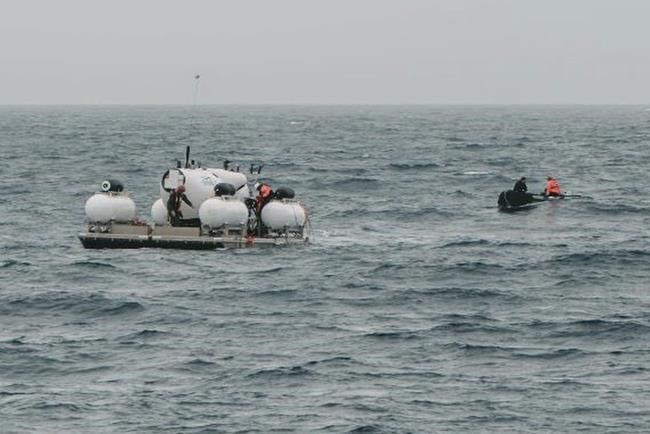A Canadian aircraft has detected underwater noise during its search for a lost sub near the wreck of the Titanic in the Atlantic Ocean.
The U.S. Coast Guard says the Canadian military plane's detection of noise while looking for the missing submersible has caused search efforts to be relocated in an effort to find the source of the sound.
There is no word on exactly what the sounds detected could indicate, but rescuers are racing to find the vessel, carrying five people, before the air supply runs out, as early as Thursday morning.
The news has offered up a glimmer of hope that the sub and its crew can be rescued after losing contact days ago during its descent to the wreck of the ill-fated luxury liner, which sank in 1912.
The U.S. Coast Guard wrote on Twitter that the noises led searchers to move an underwater robot to the area to investigate.
Those searches “have yielded negative results but continue,” the Coast Guard said.
“The data from the P-3 aircraft has been shared with our U.S. Navy experts for further analysis which will be considered in future search plans,” the Coast Guard said in the tweet.
Earlier Tuesday, U.S. Coast Guard Capt. Jamie Frederick estimated the crew of the Titan had roughly 40 hours of oxygen left as he briefed reporters.
He said the Deep Energy, a Bahamas-flagged cable layer, was in the search area with the Titan’s surface launch ship Polar Prince and was conducting an underwater search with its remotely operated vehicle, or ROV.
The ROV has limited capability but does have a camera, Frederick said. “They commenced an ROV dive at the last known position of the Titan in the approximate position of the Titanic wreck. That operation is ongoing.”
With the clock ticking down for the sub's passengers, Frederick said “Logistically speaking it’s hard to bring assets to bear. It takes time, it takes co-ordination and then we’re dealing with a surface search and a subsurface search, and that makes it an incredibly complex operation."
Dr. Ken LeDez, an anesthesiologist with an expertise in hyperbaric and diving medicine, said the submersible’s occupants are in a dire situation, especially if the vehicle has lost power. “I feel the odds are stacked against them,” LeDez, of Memorial University in St. John’s, said in an interview. “My thoughts just turn to the kind of experience that they must be having right now."
If the vessel lost power, the five would be battling decreasing oxygen supplies and increasing carbon dioxide concentrations, all in complete darkness, said LeDez. The temperature inside the chamber would also likely be plummeting if the loss of electricity wiped out their heat source.
Those on board the submersible have yet to be formally identified by authorities, but their names have been confirmed by other sources.
British businessman Hamish Harding, who lives in Dubai in the United Arab Emirates, was one of the mission specialists, according to Action Aviation, a company for which Harding serves as chairman. Also on board were Pakistani nationals Shahzada Dawood and his son Suleman, according to a family statement sent to The Associated Press.
French explorer and Titanic expert Paul-Henry Nargeolet was on board, according to David Gallo, a senior adviser for strategic initiatives and special projects at RMS Titanic Inc.
Stockton Rush, the CEO of OceanGate Expeditions, which owns the submersible, is also part of the crew, a spokesman for the company confirmed Tuesday.
This is the third year OceanGate has led expeditions to chronicle the deterioration of the Titanic, which struck an iceberg and sank in 1912, killing all but about 700 of the roughly 2,200 passengers and crew. The expeditions include archeologists and marine biologists, but the company also brings people who pay to come along. They take turns operating sonar equipment and performing other tasks in the submersible. OceanGate's website described the "mission support fee" for the 2023 expedition as US$250,000 a person.
This report by The Canadian Press was first published June 21, 2023.
The Canadian Press



